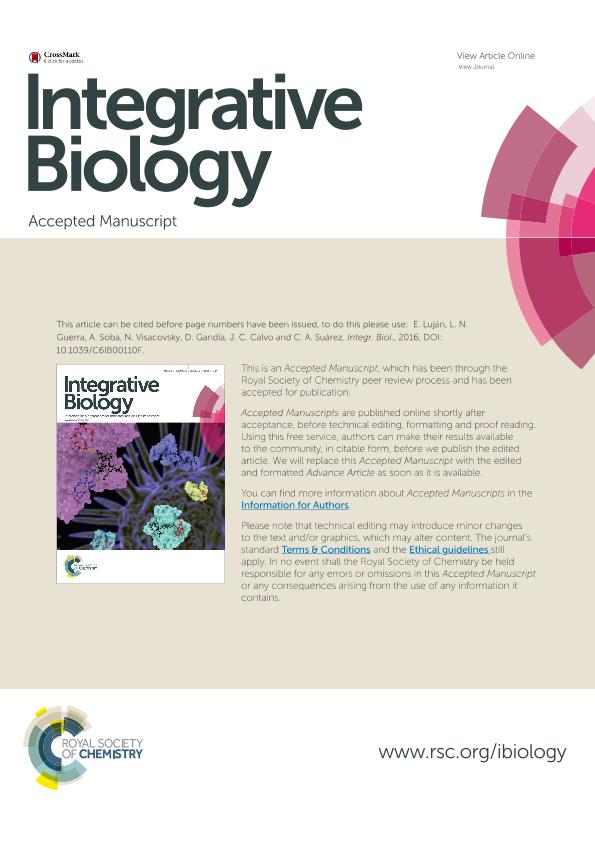Artículo
Mathematical modelling of microtumour infiltration based on in vitro experiments
Luján, Emmanuel ; Guerra, Liliana Noemi
; Guerra, Liliana Noemi ; Soba, Alejandro
; Soba, Alejandro ; Visacovsk, Nicolás; Gandia, Daniel; Calvo, Juan Carlos
; Visacovsk, Nicolás; Gandia, Daniel; Calvo, Juan Carlos ; Suárez, Cecilia Ana
; Suárez, Cecilia Ana
 ; Guerra, Liliana Noemi
; Guerra, Liliana Noemi ; Soba, Alejandro
; Soba, Alejandro ; Visacovsk, Nicolás; Gandia, Daniel; Calvo, Juan Carlos
; Visacovsk, Nicolás; Gandia, Daniel; Calvo, Juan Carlos ; Suárez, Cecilia Ana
; Suárez, Cecilia Ana
Fecha de publicación:
08/08/2016
Editorial:
Royal Society of Chemistry
Revista:
Integrative Biology
ISSN:
1757-9694
e-ISSN:
1757-9708
Idioma:
Inglés
Tipo de recurso:
Artículo publicado
Clasificación temática:
Resumen
The present mathematical models of microtumours consider, in general, volumetric growth and spherical tumour invasion shapes. Nevertheless in many cases, such as in gliomas, a need for more accurate delineation of tumour infiltration areas in a patient-specific manner has arisen. The objective of this study was to build a mathematical model able to describe in a case-specific way as well as to predict in a probabilistic way the growth and the real invasion pattern of multicellular tumour spheroids (in vitro model of an avascular microtumour) immersed in a collagen matrix. The two-dimensional theoretical model was represented by a reaction?convection?diffusion equation that considers logistic proliferation, volumetric growth, a rim with proliferative cells at the tumour surface and invasion with diffusive and convective components. Population parameter values of the model were extracted from the experimental dataset and a shape function that describes the invasion area was derived from each experimental case by image processing. New possible and aleatory shape functions were generated by data mining and Monte Carlo tools by means of a satellite EGARCH model, which were fed with all the shape functions of the dataset. Then the main model is used in two different ways: to reproduce the growth and invasion of a given experimental tumour in a case-specific manner when fed with the corresponding shape function (descriptive simulations) or to generate new possible tumour cases that respond to the general population pattern when fed with an aleatory-generated shape function (predictive simulations). Both types of simulations are in good agreement with empirical data, as it was revealed by area quantification and Bland?Altman analysis. This kind of experimental?numerical interaction has wide application potential in designing new strategies able to predict as much as possible the invasive behaviour of a tumour based on its particular characteristics and microenvironment.
Palabras clave:
Tumour Infiltration
,
In Vitro Experiments
,
Mathematical Modelling
Archivos asociados
Licencia
Identificadores
Colecciones
Articulos(CSC)
Articulos de CENTRO DE SIMULACION COMPUTACIONAL P/APLIC. TECNOLOGICAS
Articulos de CENTRO DE SIMULACION COMPUTACIONAL P/APLIC. TECNOLOGICAS
Articulos(IBYME)
Articulos de INST.DE BIOLOGIA Y MEDICINA EXPERIMENTAL (I)
Articulos de INST.DE BIOLOGIA Y MEDICINA EXPERIMENTAL (I)
Articulos(INFINA)
Articulos de INST.DE FISICA DEL PLASMA
Articulos de INST.DE FISICA DEL PLASMA
Citación
Luján, Emmanuel; Guerra, Liliana Noemi; Soba, Alejandro; Visacovsk, Nicolás; Gandia, Daniel; et al.; Mathematical modelling of microtumour infiltration based on in vitro experiments; Royal Society of Chemistry; Integrative Biology; 8; 8; 8-8-2016; 879-885
Compartir
Altmétricas



